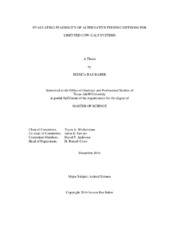| dc.description.abstract | To evaluate the performance and economic sustainability of alternative intensified cow-calf production systems, two trials were conducted and a simulation model was built. In experiment 1, a limit-fed total mixed ration (80% of NRC predicted NEm requirements, 52.88 mg/kg EBW^0.75) was separated into a roughage and concentrate component where concentrate was fed at -2, 0, 2 or 12 h after forage delivery to determine effects on nutrient utilization and solid passage rate. Experiment 2 was conducted to compare BW and BCS changes over 112 d of limit-fed production systems, fed either as a total mixed ration (TMR) or as roughage and concentrate components fed separately (SEP), to a conventional hay (HAY) fed system. A simulation model based on a cow-calf enterprise budget was constructed to determine economic viability of the three production systems. Four levels of intake (70, 85, 100, and 115% of NRC predicted NEm requirements) were compared for the two limit-fed systems, TMR and SEP. Stochastic variables in the model included weaning weights, prices of weaned steers and heifers, and feed ingredient prices.
Time of concentrate delivery relative to roughage did not affect DM or OM digestion (P ≥ 0.88). Nadir of pH was consistently observed 4 to 8 h after concentrate was delivered, but mean ruminal pH was similar among treatments (P = 0.22) ranging from 6.44 to 6.55 for 2S and 12S, respectively. Treatment did not affect final BW (1143 lb; P = 0.72) or BCS (5.6; P = 0.67), but tended to affect final RE (P = 0.06) with RE of 137.1, 98.9 and -14.6 Mcal for TMR, SEP, and HAY, respectively. Probability of negative net returns was 0.35 for HAY, which was slightly less than the probability observed in the TMR at 115% (0.37). All other probabilities for negative returns ranged from 0.13 (SEP 70%) to 0.30 (TMR 115%). Limit-feeding of TMR or separate delivery of forage and concentrate rations sustained cow performance compared to ad libitum hay consumption. Economic analysis suggests limit-feeding cattle is preferred to hay feeding, and that separate delivery of forage and concentrate would be most profitable and least risky. | en |


